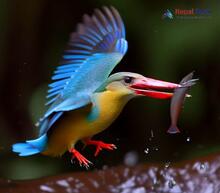A fascinating species of birds found throughout Asia, the Pelargopsis genus is known for its striking features and fascinating behavior. In this blog post, we’ll delve into the captivating world of Pelargopsis birds, covering their origin, evolution chain, taxonomy, morphology, ecology, and presence in Nepal. By the end of this article, you'll have a comprehensive understanding of these intriguing creatures.
Origin and Evolution Chain
The Pelargopsis genus belongs to the Alcedinidae family and Alcediniformes order. These birds are recognized as Stork-billed Kingfishers due to their large, stork-like bills. Fossil records suggest that the ancestors of modern kingfishers date back to around 30 million years ago during the Oligocene epoch. Over time, varying environmental conditions and isolated populations have led to the diversification and evolution of the Pelargopsis genus into several species.
Taxonomy
There are currently three recognized species in the Pelargopsis genus:
1. Pelargopsis capensis (Stork-billed Kingfisher) – Widely distributed across South Asia and Southeast Asia.
2. Pelargopsis melanorhyncha (Black-billed Kingfisher) – Found primarily in Indonesia.
3. Pelargopsis amauroptera (Brown-winged Kingfisher) – Inhabits coastal regions of India and Bangladesh.
Each species bears unique traits that allow them to thrive in their respective habitats.
Morphology
Pelargopsis birds display striking appearances characterized by a combination of vibrant colors such as blue-green upperparts and vivid orange underparts. Their most distinct feature is undoubtedly their large stork-like bills, which vary among each species. The bill can be orange-red with a dark base for P.capensis, black for P. melanorhyncha, or brownish-red for P. amauroptera. They have short legs and strong feet, enabling them to perch on branches close to the water surface while hunting.
Ecology
Pelargopsis genus birds have adapted primarily to aquatic environments, making their homes around rivers, lakes, and coastal areas. They're skilled predators who rely on their keen eyesight and agile reflexes to snatch up prey like fish, insects, and amphibians. The birds can often be found perched on branches near the water's edge, patiently awaiting their prey before quickly diving into the water to capture it.
Presence in Nepal
Nepal is home to the most widespread species of the Pelargopsis genus - the Stork-billed Kingfisher (P. capensis). The country's numerous rivers, lakes, and wetland habitats provide an ideal environment for this bird species to thrive. However, habitat loss due to urbanization and industrialization poses a threat to their survival in the region.
In conclusion, the Pelargopsis genus represents an intriguing group of kingfishers that have evolved unique characteristics over millions of years. As we continue learning about these remarkable creatures and their diverse habitats throughout Asia, including Nepal, conservation efforts are essential to preserving Pelargopsis birds for future generations to admire and appreciate.




